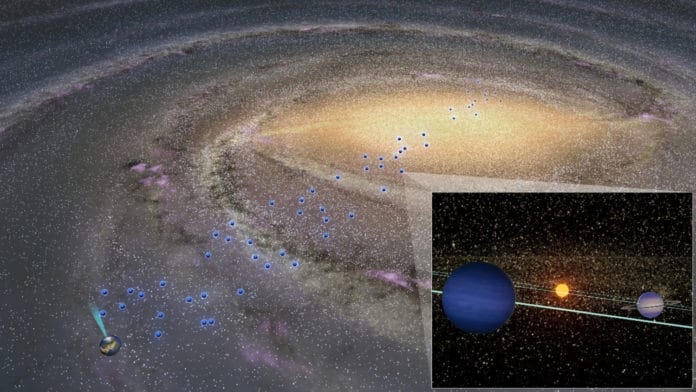Our Galaxy, Milky Way is almost 100,000 light-years across. It is quite difficult for scientists to determine the Galactic distribution of planets.
Scientists at Osaka University and NASA have overcome this hurdle. They combined observations and modeling to infer the distribution of cold planets in the Milky Way. They identified how the planet-hosting probability varies with the distance from the Galactic center.
For this study, scientists used a technique called gravitational microlensing. Gravitational microlensing is currently the only technique that helps study the Galactic distribution of planets as a function of distance from the Galactic center.
The phenomenon can be used to detect cold planets similar to Jupiter and Neptune throughout the Milky Way, from the Galactic disk to the Galactic bulge- the central region of our Galaxy.
Daisuke Suzuki, a co-author of the study, said, “Gravitational microlensing currently provides the only way to investigate the distribution of planets in the Milky Way. But until now, little is known mainly because of the difficulty in measuring the distance to planets that are more than 10,000 light-years from the Sun.”
Scientists considered the distribution of a quantity that depicts the relative motion of lens and distant light source in planetary microlensing. By comparing the distribution observed in microlensing events with that predicted by a Galactic model, the scientists could surmise the Galactic distribution of planets.
The outcomes demonstrate that the planetary distribution is not strongly dependent on the distance from the Galactic center. Instead, cold planets orbiting far from their stars seem to exist universally in the Milky Way. This includes the Galactic bulge, which has a very different environment to the solar neighborhood, and where the presence of planets has long been uncertain.
Lead author of the study Naoki Koshimoto said, “Stars in the bulge region are older and are located much closer to each other than stars in the solar neighborhood. Our finding that planets reside in both these stellar environments could lead to an improved understanding of how planets form and the history of planet formation in the Milky Way.”
Journal Reference:
- Naoki Koshimoto, David P. Bennett, Daisuke Suzuki, Ian A. Bond. No Large Dependence of Planet Frequency on Galactocentric Distance. The Astrophysical Journal Letters, 2021; 918 (1): L8 DOI: DOI: 10.3847/2041-8213/ac17ec
